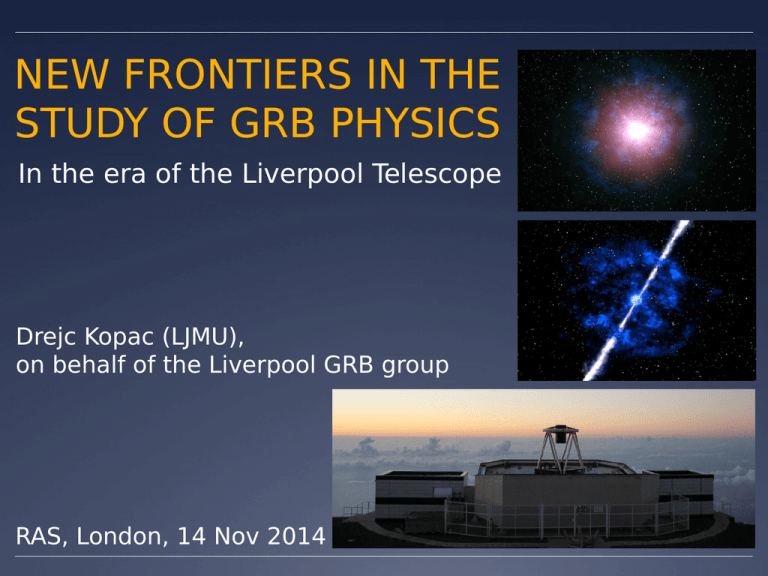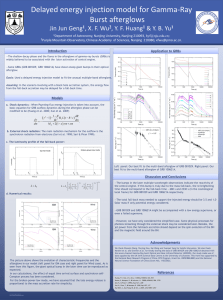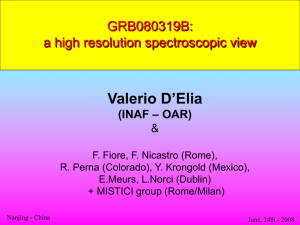NEW FRONTIERS IN THE STUDY OF GRB PHYSICS
advertisement

NEW FRONTIERS IN THE STUDY OF GRB PHYSICS In the era of the Liverpool Telescope Drejc Kopac (LJMU), on behalf of the Liverpool GRB group RAS, London, 14 Nov 2014 Gamma-Ray Burst (GRB) - The most powerful and luminous of stellar deaths - Duration: 0.01s - 1ks - Product of massive stellar collapse or NS-NS/NS-BH merger - Cosmological distances - Afterglow (X-ray, optical, radio); up to days – months Autonomous GRB Follow-up (2004) Swift LT and FTS/FTN (LCOGTN) in the Swift era Immediate automatic response (over-ride) No human intervention from receipt of alert: observations automatic object ID choice and execution of subsequent observations (Guidorzi et al. 2006) Optical afterglow light curves “Rapid” optical follow-up soon after 1997 was about 10 hrs GRB Fireball Model Reverse Shock Gehrels et al. 2007 Forward Shock Fireball Magnetization Internal shock region Standard synchrotron shock model Baryon-dominated jet creates tangled B-field in shock layer Prompt -ray variability (internal shocks) Inefficient conversion of bulk:radiated energy Alternative: Poynting flow Large-scale ordered magnetic fields advected outwards Powerful acceleration and collimation Dissipation through magnetic reconnection? Magnetic Fields Indirect diagnostics: Relative contributions of RS and FS components Color evolution diagnostic Rapid response is key Reverse+forward shock GRBs 990123, 021211, 060111B, 060117, 061126, 080319B (Gomboc et al. 2009) See also: Zhang, Kobayashi & Meszaros, 2003, ApJ Reverse Shock Sample Parent sample: 118 GRBs 10 reverse shocks with z Fainter than average FS emission @ t>10ks High magnetization: R = B,r/B,f ~ 2 – 104 Magnetized baryonic jets Japelj, Gomboc, Kopac et al. 2014, ApJ See also: Harrison & Kobayashi 2013, ApJ Prompt optical emission sample Parent sample: 36 GRBs with optical during 18 peaks Steep rise/decay Variability Internal dissipation Kopac, Kobayashi, Gomboc et al. 2013, ApJ Polarization Direct diagnostics of magnetic fields ● -ray polarization intriguing: • RHESSI: GRB 021206 P~ 0 or 70-80% • INTEGRAL: GRB 041219A P ~ 4% 43 ± 25% • IKAROS/GAP: GRB 100826A GRB 110301A GRB 110721A P=27 ± 11% P=70 ± 22% P=84 ±1628% (Coburn & Boggs 2003 vs Rutledge & Fox 2003/Wigger et al. 2003) (Gotz et al. 2009; but also McGlynn+07, Kalemci+07) (Yonetoku et al. 2011; Toma et al. 2012) • Optical polarization: • P ~ few % at late time (~ day) • Reverse shock predicted to be polarized • Rapidly fading signal RINGO POLARIMETER RINGO POLARIMETER GRB 060418 RINGO polarimetry of GRB 060418 at t = 203 s Measurement coincided with deceleration of fireball (~400; Rdec~ 1017 cm) Strongly-constrained upper-limit: P<8% Equal contribution from forward and reverse shocks REM XRT RINGO Steele et al. 2006, SPIE, 6269 ,179; Mundell et al. 2007, Science, 315, 1822 GRB 090102 Reverse shock RINGO GRB 090102 Steele et al. 2009, Nature, 462, 767 60-s RINGO exposure began t = 160 s post-burst Stars in field provide additional calibration First detection of optically polarized GRB afterglow: P=10.2±1.3% Ordered magnetic fields, low for bright RS Temporal Coverage/Evolution Complex light curves Single-shot inadequate Time-resolved polarimetry In 2009-2010 recycled RINGO into RINGO2: Fast read-out EMCCD Polaroid 8 rotations per sec 125 millisecond exposures Images not rings! GRB 120308A with RINGO2 SED modeled z ~ 2.22; RINGO2 at t=240 s (restframe 74 s); ~4000 calibration stars Mundell et al. 2013, Nature, 504, 119 GRB 120308A with RINGO2 Time-resolved polarization High, declining % Stable position angle Forward + reverse shocks Mundell et al. 2013 Nature, 504, 119 Highest measured optical polarization → Long-lived, large-scale ordered magnetic field Current State of the Art Liverpool Telescope 1 min VLT 1 hour 1 day Fireball/jet physics Large-scale geometry/ambient medium Mundell+07, Science Steele+09, Nature Cucchiara+11, ApJ Uehara+2012, ApJ Mundell+13, Nature Time in GRB restframe (sec) + 7 more poins in RINGO2 sample paper (Arnold+ in prep) 3 x RINGO2: 350 – 640 nm 650 – 750 nm 760 - 1000 nm Spectral units RINGO3 1 200 400 600 800 1000 Wavelength (nm) Core programmes: GRB and AGN/blazars Ultimately Tidal Disruption Events, Fast Radio Bursts etc? Each camera: 125-ms readout EMCCD. Data rate ~ 1Gb/min RINGO3 GRB (preliminary LC) ray X ray Optical Kopac et al. in prep Conclusions Early time multi-wavelength data is essential To characterize and understand GRB mechanism To study jet composition and geometry Also: to understand progenitors (fast spectroscopy - SPRAT) Future (especially in the context of LT2) LT2: bigger, faster → GRB luminosity function (Melandri+ 08) → extending to faint-end high-z population → Study of prompt optical and RS (also with radio, Virgili+) Complicated LCs → various components, precise modeling



